University Project Management: SIM 335 Assessment Report
VerifiedAdded on 2023/01/18
|31
|5244
|42
Report
AI Summary
This assignment is a comprehensive report on project management, addressing key concepts and practical applications. Task 1 defines project characteristics, outlines project management stages, explains the Project Initiation Document (PID), and details knowledge areas, project manager attributes, and stakeholder analysis. It also includes a network diagram and critical path analysis. Task 2 presents a case study on London Skills Concern (LSC), involving the development of an information system. The report covers project charter elements (scope, aims, objectives, assumptions, constraints, milestones), stakeholder identification and analysis, a project management plan (Gantt chart, Work Breakdown Structure), project life cycle, communication plan, cost allocation, and risk identification and mitigation. The report provides a thorough examination of project management methodologies and their practical implementation within a real-world scenario, demonstrating a strong understanding of project management principles and techniques.

Running head: MANAGING PROJECTS
SIM 335 Managing Projects Assessment Question
[Student Name]
[Student ID]
SIM 335 Managing Projects Assessment Question
[Student Name]
[Student ID]
Paraphrase This Document
Need a fresh take? Get an instant paraphrase of this document with our AI Paraphraser
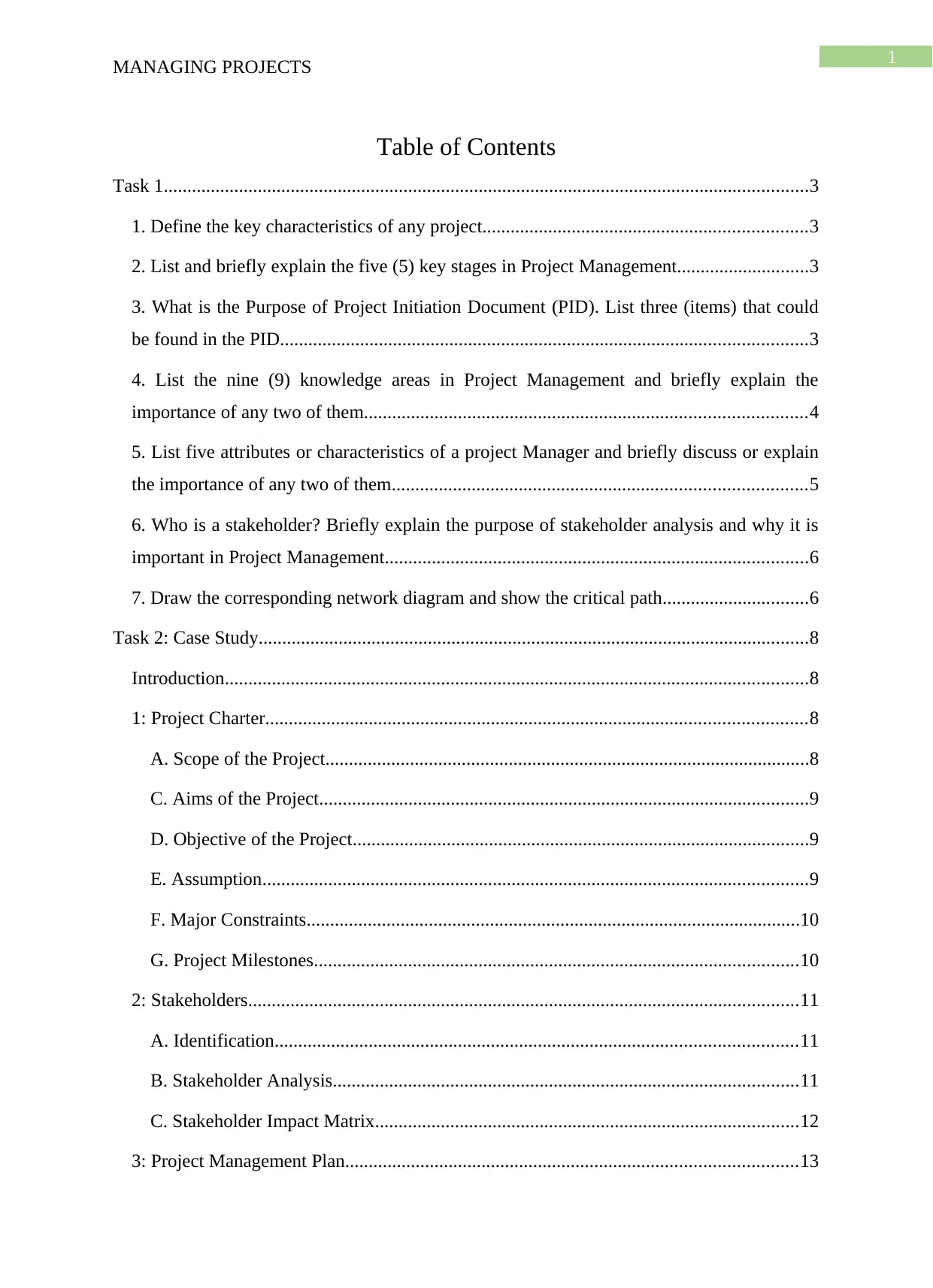
1
MANAGING PROJECTS
Table of Contents
Task 1.........................................................................................................................................3
1. Define the key characteristics of any project.....................................................................3
2. List and briefly explain the five (5) key stages in Project Management............................3
3. What is the Purpose of Project Initiation Document (PID). List three (items) that could
be found in the PID................................................................................................................3
4. List the nine (9) knowledge areas in Project Management and briefly explain the
importance of any two of them..............................................................................................4
5. List five attributes or characteristics of a project Manager and briefly discuss or explain
the importance of any two of them........................................................................................5
6. Who is a stakeholder? Briefly explain the purpose of stakeholder analysis and why it is
important in Project Management..........................................................................................6
7. Draw the corresponding network diagram and show the critical path...............................6
Task 2: Case Study.....................................................................................................................8
Introduction............................................................................................................................8
1: Project Charter...................................................................................................................8
A. Scope of the Project.......................................................................................................8
C. Aims of the Project........................................................................................................9
D. Objective of the Project.................................................................................................9
E. Assumption....................................................................................................................9
F. Major Constraints.........................................................................................................10
G. Project Milestones.......................................................................................................10
2: Stakeholders.....................................................................................................................11
A. Identification...............................................................................................................11
B. Stakeholder Analysis...................................................................................................11
C. Stakeholder Impact Matrix..........................................................................................12
3: Project Management Plan................................................................................................13
MANAGING PROJECTS
Table of Contents
Task 1.........................................................................................................................................3
1. Define the key characteristics of any project.....................................................................3
2. List and briefly explain the five (5) key stages in Project Management............................3
3. What is the Purpose of Project Initiation Document (PID). List three (items) that could
be found in the PID................................................................................................................3
4. List the nine (9) knowledge areas in Project Management and briefly explain the
importance of any two of them..............................................................................................4
5. List five attributes or characteristics of a project Manager and briefly discuss or explain
the importance of any two of them........................................................................................5
6. Who is a stakeholder? Briefly explain the purpose of stakeholder analysis and why it is
important in Project Management..........................................................................................6
7. Draw the corresponding network diagram and show the critical path...............................6
Task 2: Case Study.....................................................................................................................8
Introduction............................................................................................................................8
1: Project Charter...................................................................................................................8
A. Scope of the Project.......................................................................................................8
C. Aims of the Project........................................................................................................9
D. Objective of the Project.................................................................................................9
E. Assumption....................................................................................................................9
F. Major Constraints.........................................................................................................10
G. Project Milestones.......................................................................................................10
2: Stakeholders.....................................................................................................................11
A. Identification...............................................................................................................11
B. Stakeholder Analysis...................................................................................................11
C. Stakeholder Impact Matrix..........................................................................................12
3: Project Management Plan................................................................................................13
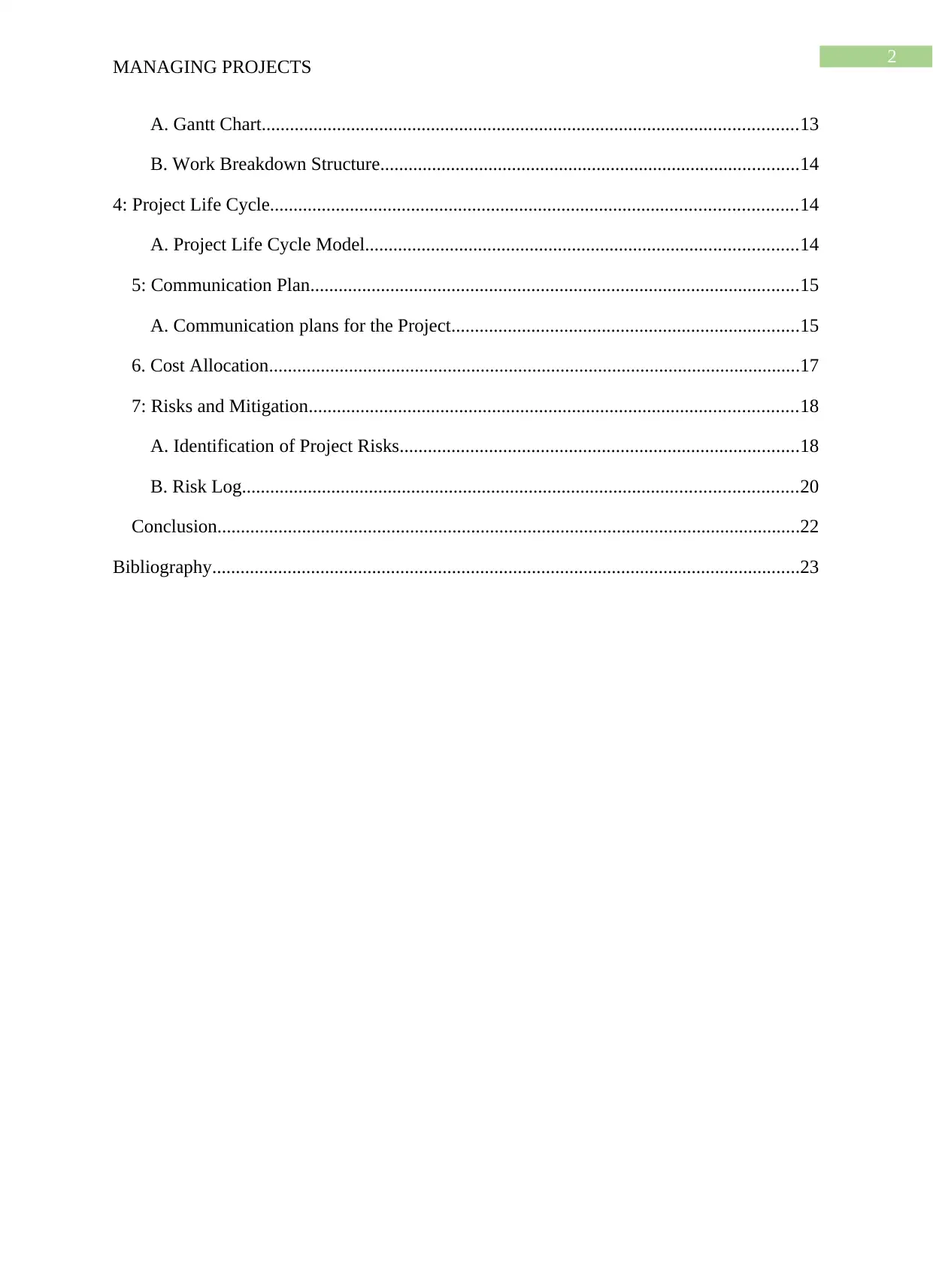
2
MANAGING PROJECTS
A. Gantt Chart..................................................................................................................13
B. Work Breakdown Structure.........................................................................................14
4: Project Life Cycle................................................................................................................14
A. Project Life Cycle Model............................................................................................14
5: Communication Plan........................................................................................................15
A. Communication plans for the Project..........................................................................15
6. Cost Allocation.................................................................................................................17
7: Risks and Mitigation........................................................................................................18
A. Identification of Project Risks.....................................................................................18
B. Risk Log......................................................................................................................20
Conclusion............................................................................................................................22
Bibliography.............................................................................................................................23
MANAGING PROJECTS
A. Gantt Chart..................................................................................................................13
B. Work Breakdown Structure.........................................................................................14
4: Project Life Cycle................................................................................................................14
A. Project Life Cycle Model............................................................................................14
5: Communication Plan........................................................................................................15
A. Communication plans for the Project..........................................................................15
6. Cost Allocation.................................................................................................................17
7: Risks and Mitigation........................................................................................................18
A. Identification of Project Risks.....................................................................................18
B. Risk Log......................................................................................................................20
Conclusion............................................................................................................................22
Bibliography.............................................................................................................................23
⊘ This is a preview!⊘
Do you want full access?
Subscribe today to unlock all pages.

Trusted by 1+ million students worldwide
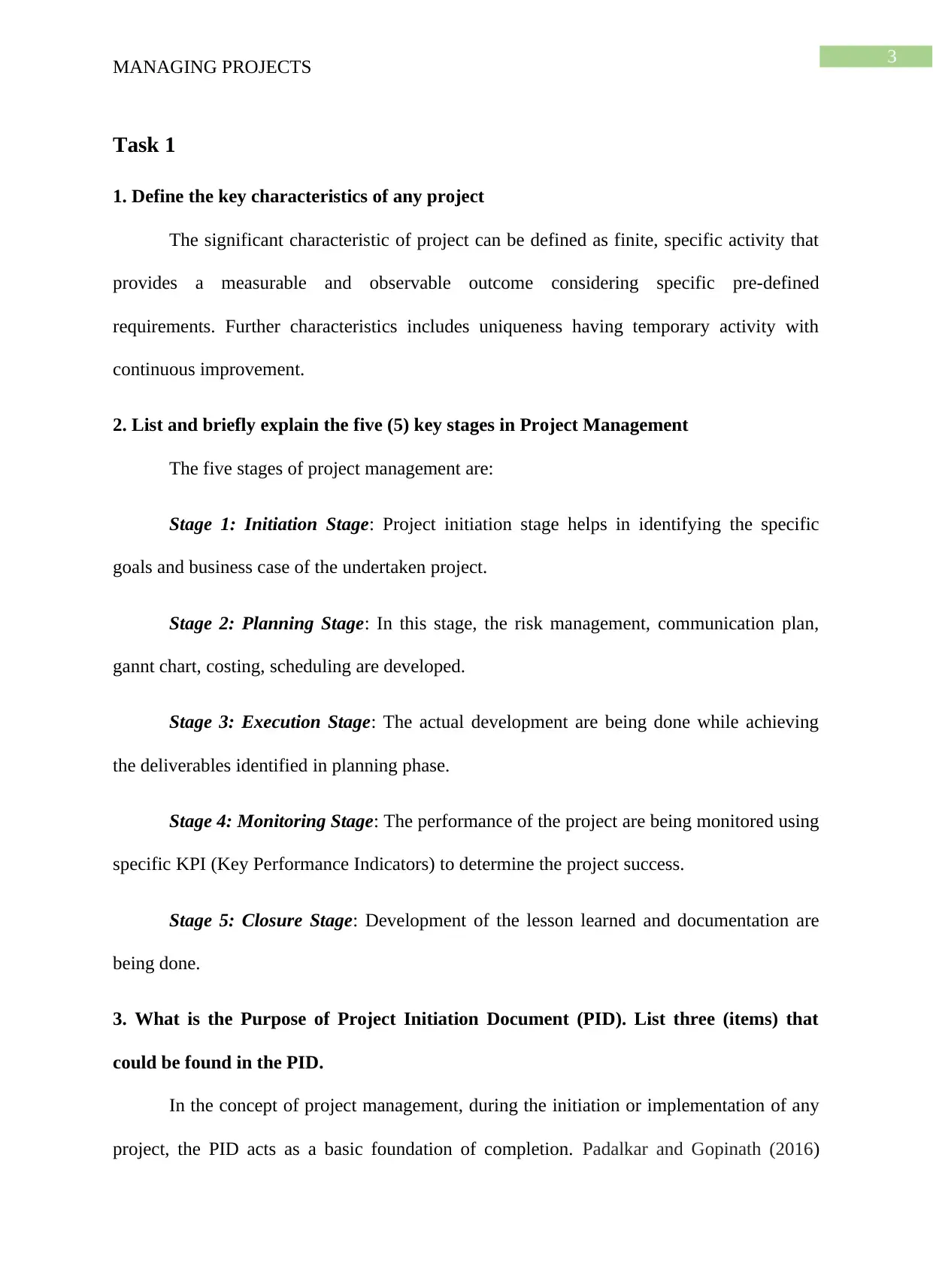
3
MANAGING PROJECTS
Task 1
1. Define the key characteristics of any project
The significant characteristic of project can be defined as finite, specific activity that
provides a measurable and observable outcome considering specific pre-defined
requirements. Further characteristics includes uniqueness having temporary activity with
continuous improvement.
2. List and briefly explain the five (5) key stages in Project Management
The five stages of project management are:
Stage 1: Initiation Stage: Project initiation stage helps in identifying the specific
goals and business case of the undertaken project.
Stage 2: Planning Stage: In this stage, the risk management, communication plan,
gannt chart, costing, scheduling are developed.
Stage 3: Execution Stage: The actual development are being done while achieving
the deliverables identified in planning phase.
Stage 4: Monitoring Stage: The performance of the project are being monitored using
specific KPI (Key Performance Indicators) to determine the project success.
Stage 5: Closure Stage: Development of the lesson learned and documentation are
being done.
3. What is the Purpose of Project Initiation Document (PID). List three (items) that
could be found in the PID.
In the concept of project management, during the initiation or implementation of any
project, the PID acts as a basic foundation of completion. Padalkar and Gopinath (2016)
MANAGING PROJECTS
Task 1
1. Define the key characteristics of any project
The significant characteristic of project can be defined as finite, specific activity that
provides a measurable and observable outcome considering specific pre-defined
requirements. Further characteristics includes uniqueness having temporary activity with
continuous improvement.
2. List and briefly explain the five (5) key stages in Project Management
The five stages of project management are:
Stage 1: Initiation Stage: Project initiation stage helps in identifying the specific
goals and business case of the undertaken project.
Stage 2: Planning Stage: In this stage, the risk management, communication plan,
gannt chart, costing, scheduling are developed.
Stage 3: Execution Stage: The actual development are being done while achieving
the deliverables identified in planning phase.
Stage 4: Monitoring Stage: The performance of the project are being monitored using
specific KPI (Key Performance Indicators) to determine the project success.
Stage 5: Closure Stage: Development of the lesson learned and documentation are
being done.
3. What is the Purpose of Project Initiation Document (PID). List three (items) that
could be found in the PID.
In the concept of project management, during the initiation or implementation of any
project, the PID acts as a basic foundation of completion. Padalkar and Gopinath (2016)
Paraphrase This Document
Need a fresh take? Get an instant paraphrase of this document with our AI Paraphraser
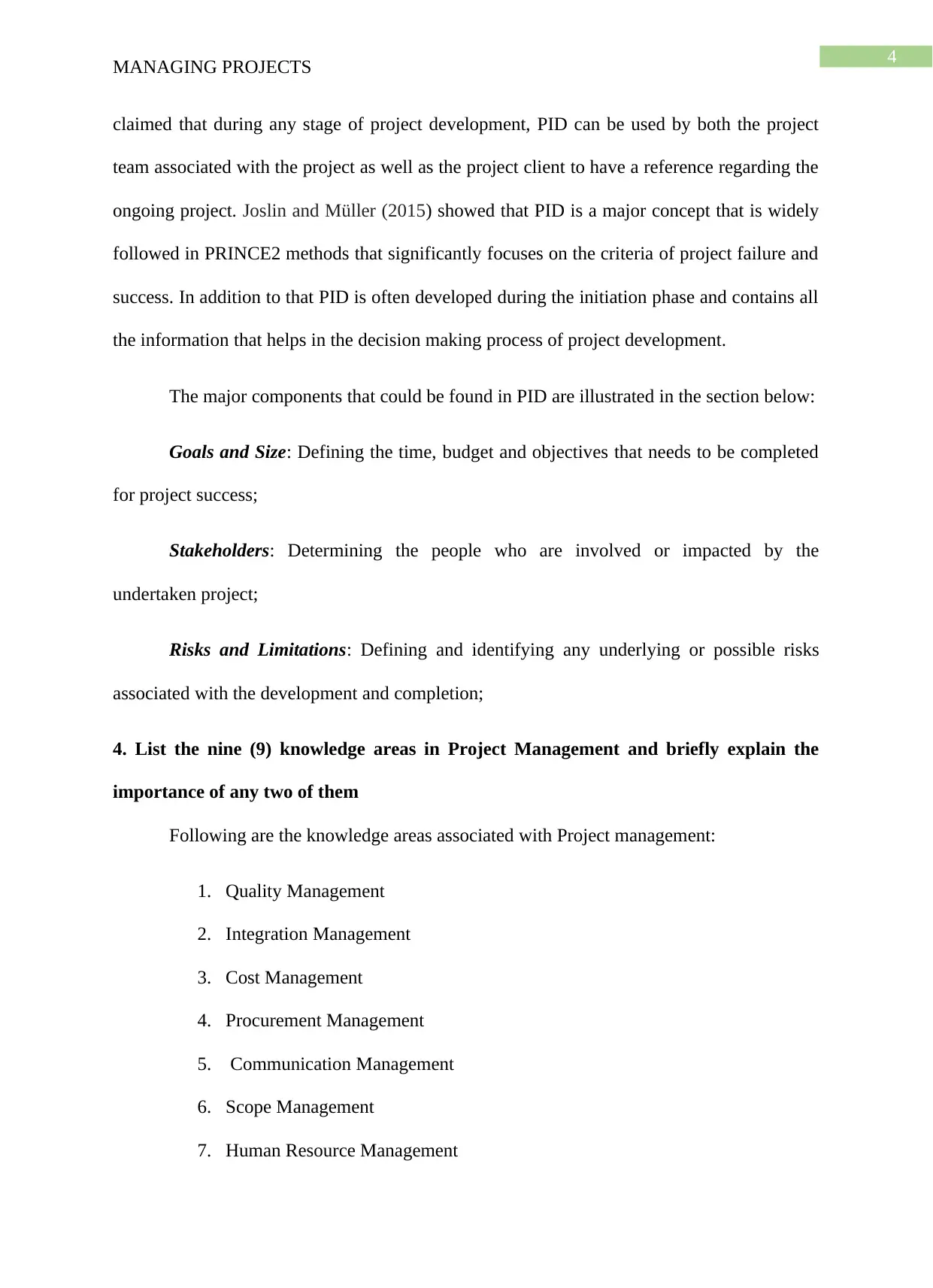
4
MANAGING PROJECTS
claimed that during any stage of project development, PID can be used by both the project
team associated with the project as well as the project client to have a reference regarding the
ongoing project. Joslin and Müller (2015) showed that PID is a major concept that is widely
followed in PRINCE2 methods that significantly focuses on the criteria of project failure and
success. In addition to that PID is often developed during the initiation phase and contains all
the information that helps in the decision making process of project development.
The major components that could be found in PID are illustrated in the section below:
Goals and Size: Defining the time, budget and objectives that needs to be completed
for project success;
Stakeholders: Determining the people who are involved or impacted by the
undertaken project;
Risks and Limitations: Defining and identifying any underlying or possible risks
associated with the development and completion;
4. List the nine (9) knowledge areas in Project Management and briefly explain the
importance of any two of them
Following are the knowledge areas associated with Project management:
1. Quality Management
2. Integration Management
3. Cost Management
4. Procurement Management
5. Communication Management
6. Scope Management
7. Human Resource Management
MANAGING PROJECTS
claimed that during any stage of project development, PID can be used by both the project
team associated with the project as well as the project client to have a reference regarding the
ongoing project. Joslin and Müller (2015) showed that PID is a major concept that is widely
followed in PRINCE2 methods that significantly focuses on the criteria of project failure and
success. In addition to that PID is often developed during the initiation phase and contains all
the information that helps in the decision making process of project development.
The major components that could be found in PID are illustrated in the section below:
Goals and Size: Defining the time, budget and objectives that needs to be completed
for project success;
Stakeholders: Determining the people who are involved or impacted by the
undertaken project;
Risks and Limitations: Defining and identifying any underlying or possible risks
associated with the development and completion;
4. List the nine (9) knowledge areas in Project Management and briefly explain the
importance of any two of them
Following are the knowledge areas associated with Project management:
1. Quality Management
2. Integration Management
3. Cost Management
4. Procurement Management
5. Communication Management
6. Scope Management
7. Human Resource Management
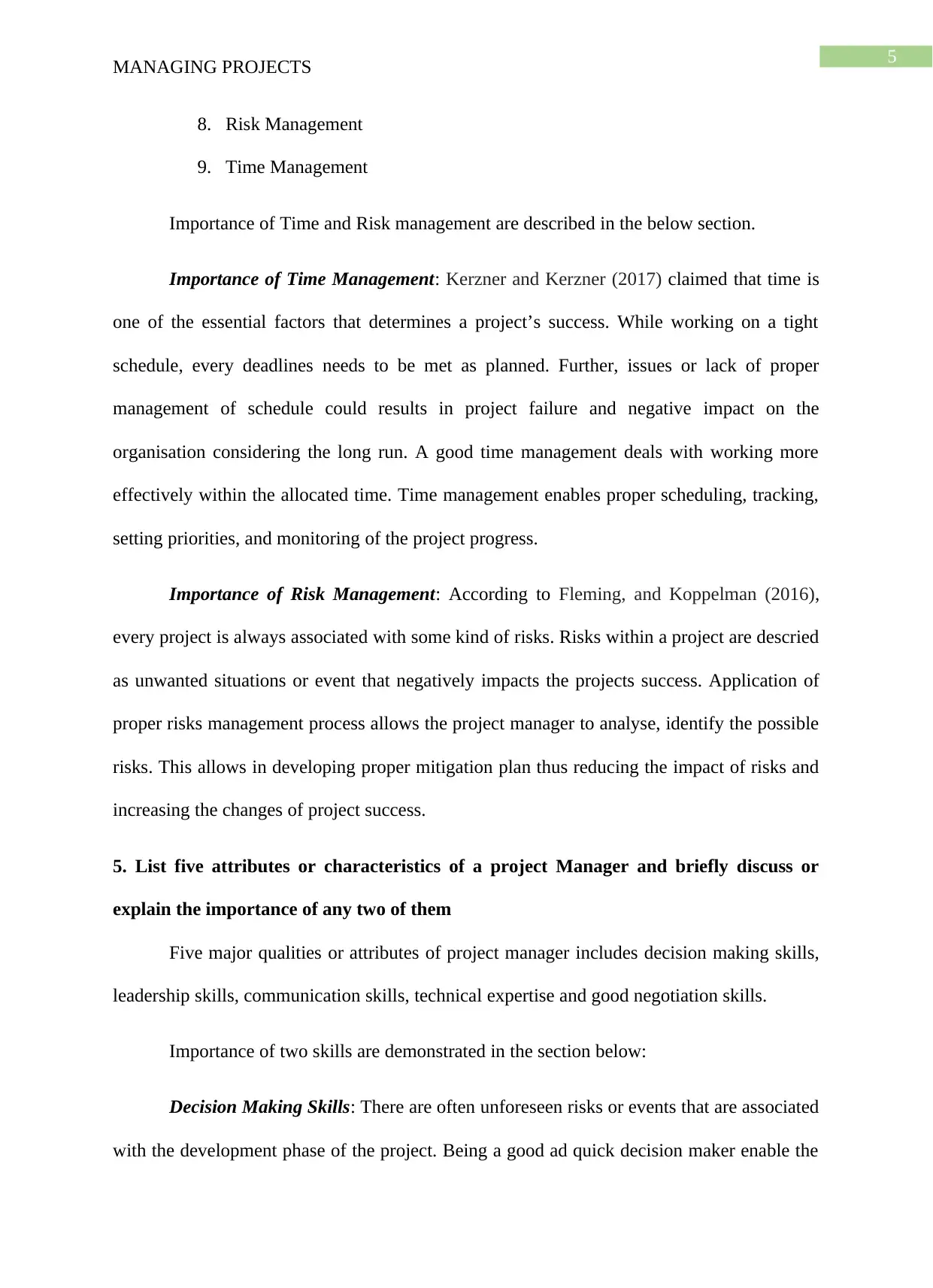
5
MANAGING PROJECTS
8. Risk Management
9. Time Management
Importance of Time and Risk management are described in the below section.
Importance of Time Management: Kerzner and Kerzner (2017) claimed that time is
one of the essential factors that determines a project’s success. While working on a tight
schedule, every deadlines needs to be met as planned. Further, issues or lack of proper
management of schedule could results in project failure and negative impact on the
organisation considering the long run. A good time management deals with working more
effectively within the allocated time. Time management enables proper scheduling, tracking,
setting priorities, and monitoring of the project progress.
Importance of Risk Management: According to Fleming, and Koppelman (2016),
every project is always associated with some kind of risks. Risks within a project are descried
as unwanted situations or event that negatively impacts the projects success. Application of
proper risks management process allows the project manager to analyse, identify the possible
risks. This allows in developing proper mitigation plan thus reducing the impact of risks and
increasing the changes of project success.
5. List five attributes or characteristics of a project Manager and briefly discuss or
explain the importance of any two of them
Five major qualities or attributes of project manager includes decision making skills,
leadership skills, communication skills, technical expertise and good negotiation skills.
Importance of two skills are demonstrated in the section below:
Decision Making Skills: There are often unforeseen risks or events that are associated
with the development phase of the project. Being a good ad quick decision maker enable the
MANAGING PROJECTS
8. Risk Management
9. Time Management
Importance of Time and Risk management are described in the below section.
Importance of Time Management: Kerzner and Kerzner (2017) claimed that time is
one of the essential factors that determines a project’s success. While working on a tight
schedule, every deadlines needs to be met as planned. Further, issues or lack of proper
management of schedule could results in project failure and negative impact on the
organisation considering the long run. A good time management deals with working more
effectively within the allocated time. Time management enables proper scheduling, tracking,
setting priorities, and monitoring of the project progress.
Importance of Risk Management: According to Fleming, and Koppelman (2016),
every project is always associated with some kind of risks. Risks within a project are descried
as unwanted situations or event that negatively impacts the projects success. Application of
proper risks management process allows the project manager to analyse, identify the possible
risks. This allows in developing proper mitigation plan thus reducing the impact of risks and
increasing the changes of project success.
5. List five attributes or characteristics of a project Manager and briefly discuss or
explain the importance of any two of them
Five major qualities or attributes of project manager includes decision making skills,
leadership skills, communication skills, technical expertise and good negotiation skills.
Importance of two skills are demonstrated in the section below:
Decision Making Skills: There are often unforeseen risks or events that are associated
with the development phase of the project. Being a good ad quick decision maker enable the
⊘ This is a preview!⊘
Do you want full access?
Subscribe today to unlock all pages.

Trusted by 1+ million students worldwide
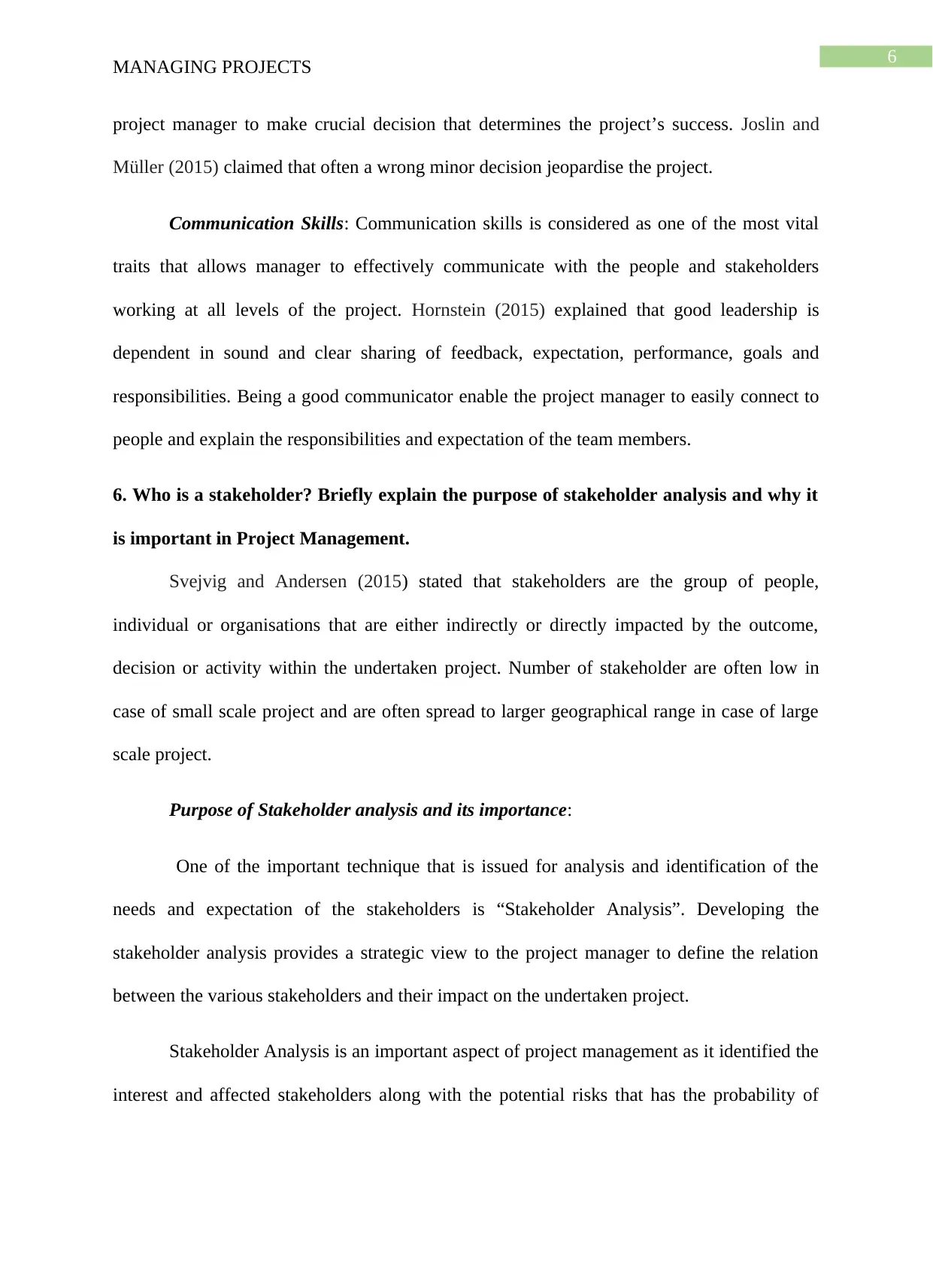
6
MANAGING PROJECTS
project manager to make crucial decision that determines the project’s success. Joslin and
Müller (2015) claimed that often a wrong minor decision jeopardise the project.
Communication Skills: Communication skills is considered as one of the most vital
traits that allows manager to effectively communicate with the people and stakeholders
working at all levels of the project. Hornstein (2015) explained that good leadership is
dependent in sound and clear sharing of feedback, expectation, performance, goals and
responsibilities. Being a good communicator enable the project manager to easily connect to
people and explain the responsibilities and expectation of the team members.
6. Who is a stakeholder? Briefly explain the purpose of stakeholder analysis and why it
is important in Project Management.
Svejvig and Andersen (2015) stated that stakeholders are the group of people,
individual or organisations that are either indirectly or directly impacted by the outcome,
decision or activity within the undertaken project. Number of stakeholder are often low in
case of small scale project and are often spread to larger geographical range in case of large
scale project.
Purpose of Stakeholder analysis and its importance:
One of the important technique that is issued for analysis and identification of the
needs and expectation of the stakeholders is “Stakeholder Analysis”. Developing the
stakeholder analysis provides a strategic view to the project manager to define the relation
between the various stakeholders and their impact on the undertaken project.
Stakeholder Analysis is an important aspect of project management as it identified the
interest and affected stakeholders along with the potential risks that has the probability of
MANAGING PROJECTS
project manager to make crucial decision that determines the project’s success. Joslin and
Müller (2015) claimed that often a wrong minor decision jeopardise the project.
Communication Skills: Communication skills is considered as one of the most vital
traits that allows manager to effectively communicate with the people and stakeholders
working at all levels of the project. Hornstein (2015) explained that good leadership is
dependent in sound and clear sharing of feedback, expectation, performance, goals and
responsibilities. Being a good communicator enable the project manager to easily connect to
people and explain the responsibilities and expectation of the team members.
6. Who is a stakeholder? Briefly explain the purpose of stakeholder analysis and why it
is important in Project Management.
Svejvig and Andersen (2015) stated that stakeholders are the group of people,
individual or organisations that are either indirectly or directly impacted by the outcome,
decision or activity within the undertaken project. Number of stakeholder are often low in
case of small scale project and are often spread to larger geographical range in case of large
scale project.
Purpose of Stakeholder analysis and its importance:
One of the important technique that is issued for analysis and identification of the
needs and expectation of the stakeholders is “Stakeholder Analysis”. Developing the
stakeholder analysis provides a strategic view to the project manager to define the relation
between the various stakeholders and their impact on the undertaken project.
Stakeholder Analysis is an important aspect of project management as it identified the
interest and affected stakeholders along with the potential risks that has the probability of
Paraphrase This Document
Need a fresh take? Get an instant paraphrase of this document with our AI Paraphraser

7
MANAGING PROJECTS
disrupting project success. In addition to that, it identified the stakeholders with whom the
information needs to be shared at different stage.
MANAGING PROJECTS
disrupting project success. In addition to that, it identified the stakeholders with whom the
information needs to be shared at different stage.
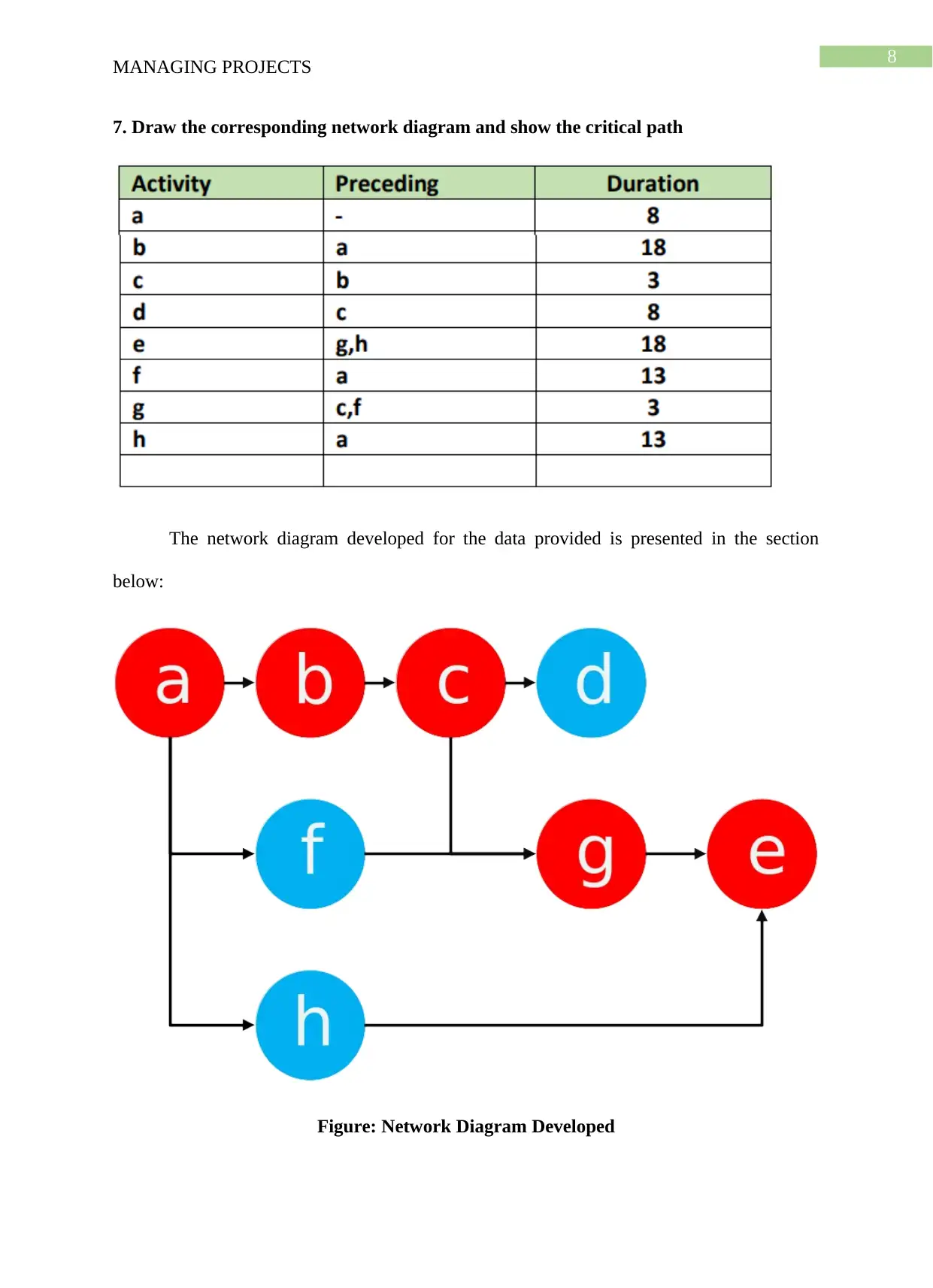
8
MANAGING PROJECTS
7. Draw the corresponding network diagram and show the critical path
The network diagram developed for the data provided is presented in the section
below:
Figure: Network Diagram Developed
MANAGING PROJECTS
7. Draw the corresponding network diagram and show the critical path
The network diagram developed for the data provided is presented in the section
below:
Figure: Network Diagram Developed
⊘ This is a preview!⊘
Do you want full access?
Subscribe today to unlock all pages.

Trusted by 1+ million students worldwide
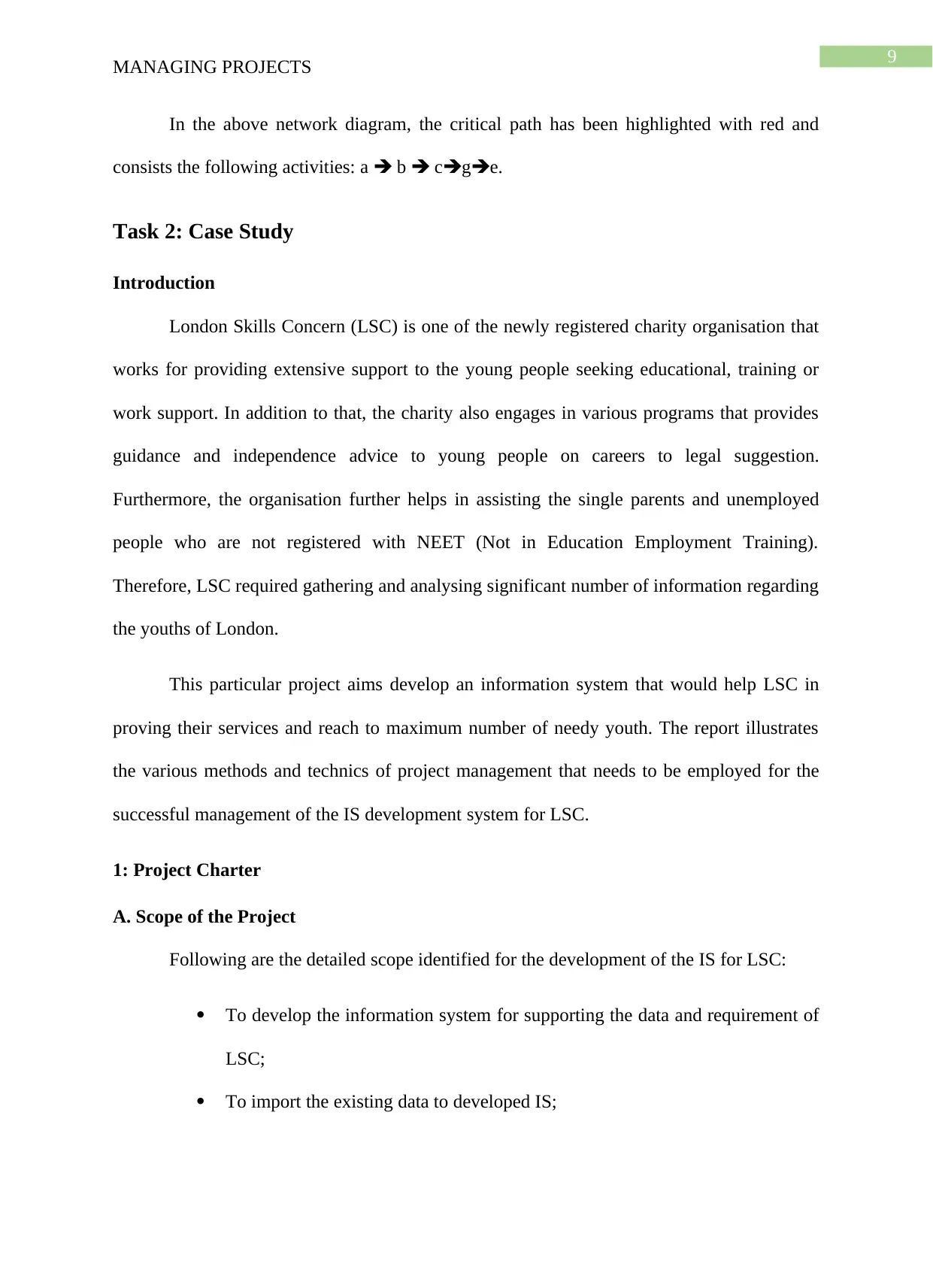
9
MANAGING PROJECTS
In the above network diagram, the critical path has been highlighted with red and
consists the following activities: a b cge.
Task 2: Case Study
Introduction
London Skills Concern (LSC) is one of the newly registered charity organisation that
works for providing extensive support to the young people seeking educational, training or
work support. In addition to that, the charity also engages in various programs that provides
guidance and independence advice to young people on careers to legal suggestion.
Furthermore, the organisation further helps in assisting the single parents and unemployed
people who are not registered with NEET (Not in Education Employment Training).
Therefore, LSC required gathering and analysing significant number of information regarding
the youths of London.
This particular project aims develop an information system that would help LSC in
proving their services and reach to maximum number of needy youth. The report illustrates
the various methods and technics of project management that needs to be employed for the
successful management of the IS development system for LSC.
1: Project Charter
A. Scope of the Project
Following are the detailed scope identified for the development of the IS for LSC:
To develop the information system for supporting the data and requirement of
LSC;
To import the existing data to developed IS;
MANAGING PROJECTS
In the above network diagram, the critical path has been highlighted with red and
consists the following activities: a b cge.
Task 2: Case Study
Introduction
London Skills Concern (LSC) is one of the newly registered charity organisation that
works for providing extensive support to the young people seeking educational, training or
work support. In addition to that, the charity also engages in various programs that provides
guidance and independence advice to young people on careers to legal suggestion.
Furthermore, the organisation further helps in assisting the single parents and unemployed
people who are not registered with NEET (Not in Education Employment Training).
Therefore, LSC required gathering and analysing significant number of information regarding
the youths of London.
This particular project aims develop an information system that would help LSC in
proving their services and reach to maximum number of needy youth. The report illustrates
the various methods and technics of project management that needs to be employed for the
successful management of the IS development system for LSC.
1: Project Charter
A. Scope of the Project
Following are the detailed scope identified for the development of the IS for LSC:
To develop the information system for supporting the data and requirement of
LSC;
To import the existing data to developed IS;
Paraphrase This Document
Need a fresh take? Get an instant paraphrase of this document with our AI Paraphraser
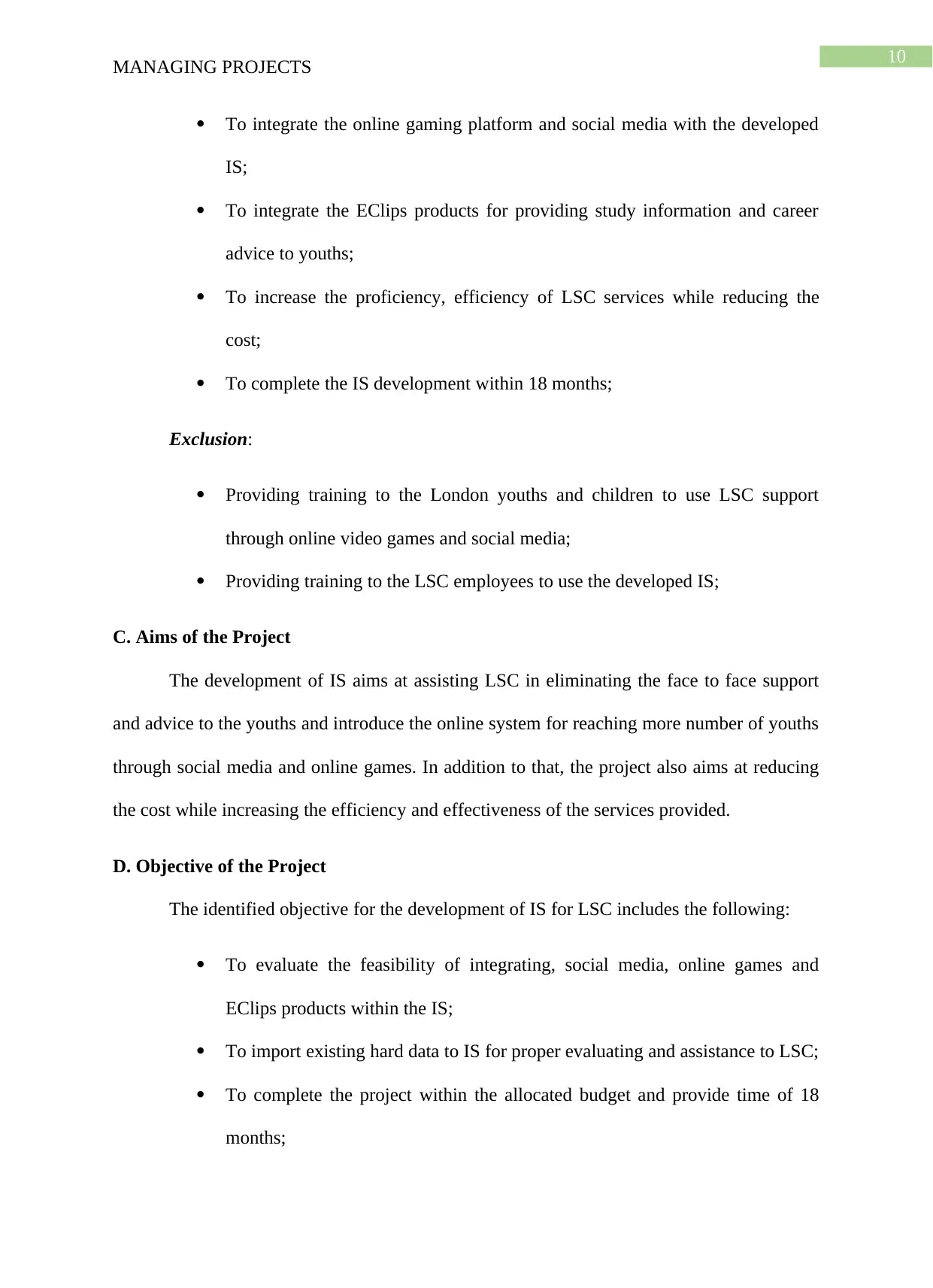
10
MANAGING PROJECTS
To integrate the online gaming platform and social media with the developed
IS;
To integrate the EClips products for providing study information and career
advice to youths;
To increase the proficiency, efficiency of LSC services while reducing the
cost;
To complete the IS development within 18 months;
Exclusion:
Providing training to the London youths and children to use LSC support
through online video games and social media;
Providing training to the LSC employees to use the developed IS;
C. Aims of the Project
The development of IS aims at assisting LSC in eliminating the face to face support
and advice to the youths and introduce the online system for reaching more number of youths
through social media and online games. In addition to that, the project also aims at reducing
the cost while increasing the efficiency and effectiveness of the services provided.
D. Objective of the Project
The identified objective for the development of IS for LSC includes the following:
To evaluate the feasibility of integrating, social media, online games and
EClips products within the IS;
To import existing hard data to IS for proper evaluating and assistance to LSC;
To complete the project within the allocated budget and provide time of 18
months;
MANAGING PROJECTS
To integrate the online gaming platform and social media with the developed
IS;
To integrate the EClips products for providing study information and career
advice to youths;
To increase the proficiency, efficiency of LSC services while reducing the
cost;
To complete the IS development within 18 months;
Exclusion:
Providing training to the London youths and children to use LSC support
through online video games and social media;
Providing training to the LSC employees to use the developed IS;
C. Aims of the Project
The development of IS aims at assisting LSC in eliminating the face to face support
and advice to the youths and introduce the online system for reaching more number of youths
through social media and online games. In addition to that, the project also aims at reducing
the cost while increasing the efficiency and effectiveness of the services provided.
D. Objective of the Project
The identified objective for the development of IS for LSC includes the following:
To evaluate the feasibility of integrating, social media, online games and
EClips products within the IS;
To import existing hard data to IS for proper evaluating and assistance to LSC;
To complete the project within the allocated budget and provide time of 18
months;
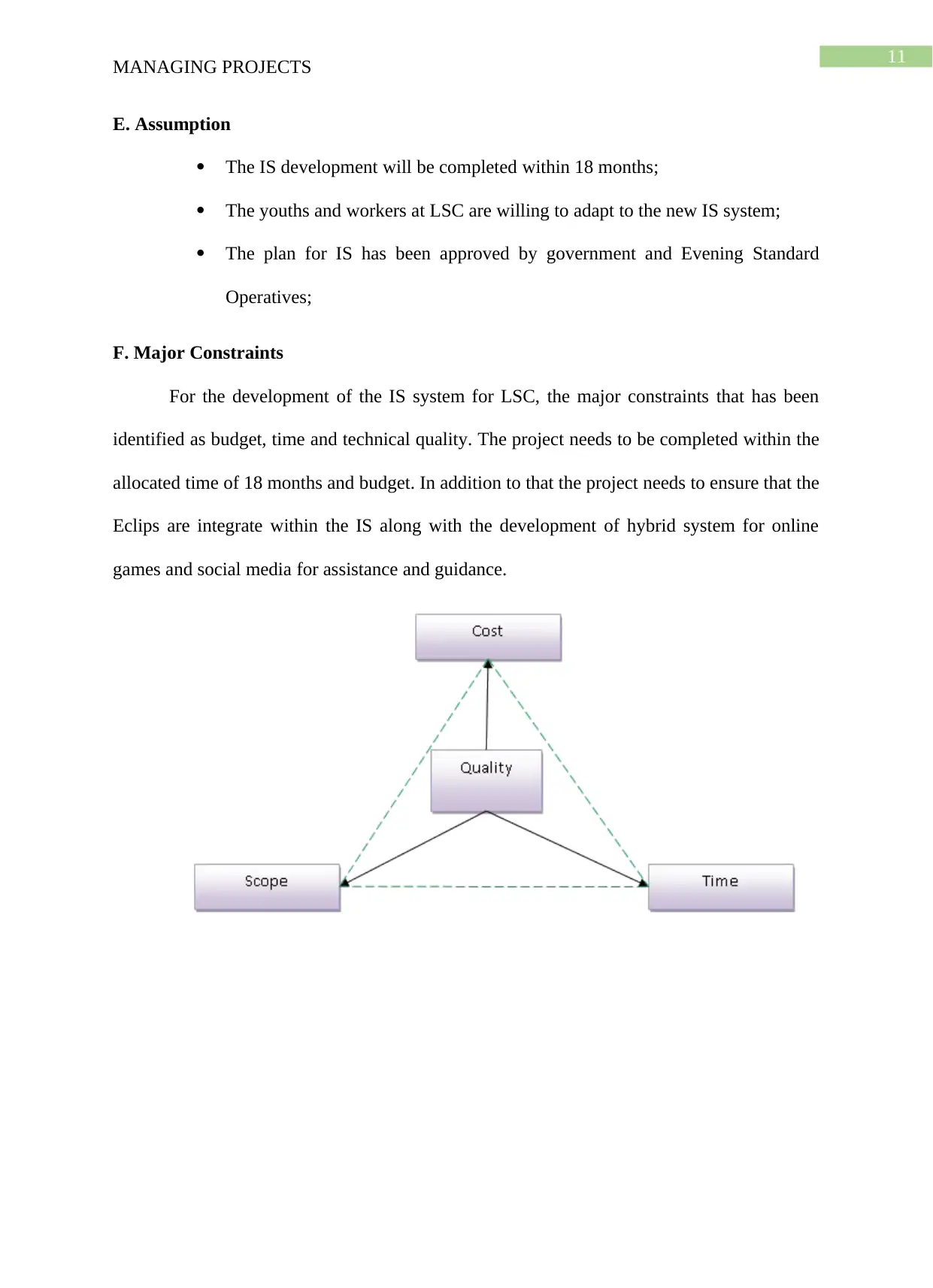
11
MANAGING PROJECTS
E. Assumption
The IS development will be completed within 18 months;
The youths and workers at LSC are willing to adapt to the new IS system;
The plan for IS has been approved by government and Evening Standard
Operatives;
F. Major Constraints
For the development of the IS system for LSC, the major constraints that has been
identified as budget, time and technical quality. The project needs to be completed within the
allocated time of 18 months and budget. In addition to that the project needs to ensure that the
Eclips are integrate within the IS along with the development of hybrid system for online
games and social media for assistance and guidance.
MANAGING PROJECTS
E. Assumption
The IS development will be completed within 18 months;
The youths and workers at LSC are willing to adapt to the new IS system;
The plan for IS has been approved by government and Evening Standard
Operatives;
F. Major Constraints
For the development of the IS system for LSC, the major constraints that has been
identified as budget, time and technical quality. The project needs to be completed within the
allocated time of 18 months and budget. In addition to that the project needs to ensure that the
Eclips are integrate within the IS along with the development of hybrid system for online
games and social media for assistance and guidance.
⊘ This is a preview!⊘
Do you want full access?
Subscribe today to unlock all pages.

Trusted by 1+ million students worldwide
1 out of 31
Related Documents
Your All-in-One AI-Powered Toolkit for Academic Success.
+13062052269
info@desklib.com
Available 24*7 on WhatsApp / Email
![[object Object]](/_next/static/media/star-bottom.7253800d.svg)
Unlock your academic potential
Copyright © 2020–2025 A2Z Services. All Rights Reserved. Developed and managed by ZUCOL.


